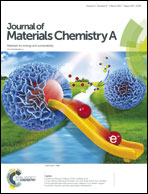Surface functionalization of high free-volume polymers as a route to efficient hydrogen separation membranes†
Abstract
There is a sparcity of polymeric membranes with sufficient selectivity for efficient hydrogen separation from syn-gas products, primarily carbon dioxide. Despite hydrogen's significantly smaller kinetic diameter, low selectivity arises as other gases are generally more condensable within typical polymeric membranes. Here we report an in situ-controllable, surface polymerization of polydopamine (PDA) and polyaniline (PANI) on high free-volume glassy polymer films, specifically the well studied polymer of intrinsic microporosity (PIM-1) and poly(1-trimethylsilyl-1-propyne) (PTMSP). The resulting nanolayer composite membranes demonstrate a remarkable hydrogen selectivity against N2, CH4 and CO2 (H2/CO2 ∼ 50). The PDA or PANI layers principally serve to increase the diffusive selectivity towards hydrogen whilst the high free volume supports of PIM-1 or PTMSP provide a highly permeable interface for defect-free growth of the selective layer. Whilst both PANI and PDA are effective, these selective layers were found to grow by heterogeneous or homogeneous modes respectively.



 Please wait while we load your content...
Please wait while we load your content...